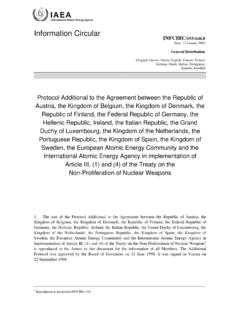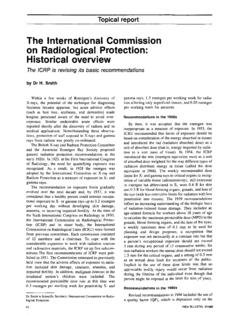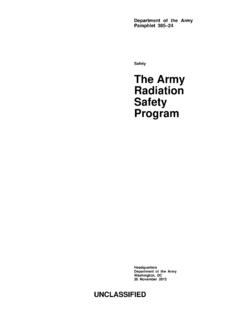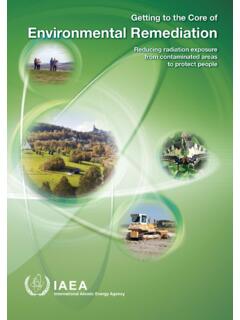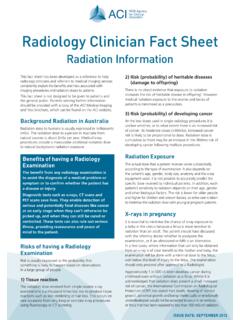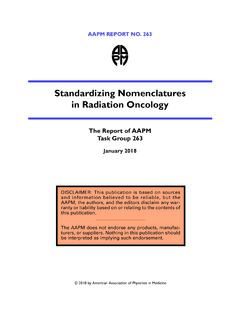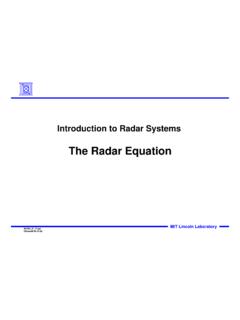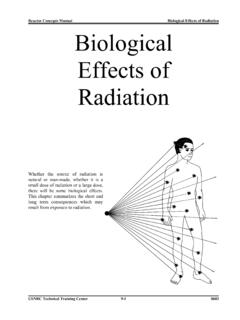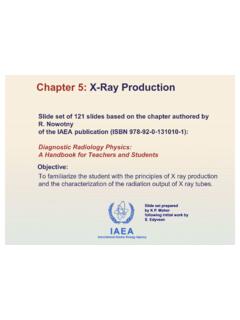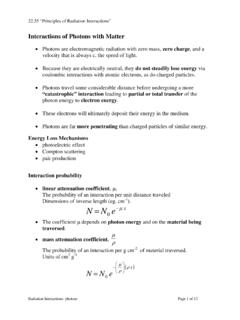Transcription of RADIATION, PEOPLE AND THE ENVIRONMENT
1 Printed by the IAEA in Austria, February 2004 IAEA/ / 04-00391 Division of radiation and Waste Wrixon; I. Barraclough; Clark (Consultant)Division of Public Information:J. Ford (Editor); A. Diesner-Kuepfer (Design, Illustration and Layout);B. Blann (Photo Support) radiation , PEOPLE AND THE ENVIRONMENTRADIATION, PEOPLE AND THE a broad overview of ionizing radiation , its effects and uses, as well as the measures in place to use it safelyCONTENTSC hapter 1 Introduction 1 Benefits and risks 2 / Public anxiety 2 Chapter 2 Atoms and radiation 3 Structure of matter 3 / Radioactivity and radiation 4 / Types of radiation 7 Chapter 3 radiation and matter 9 Ionization in tissue 10 / Dose quantities 11 Chapter 4 Sources of ionizing radiation 13 Chapter 5 radiation effects 15 Induction of cancers 16 / Risk assessments 16 / Risk factors for cancers 17 Hereditary disease 19 / Communal risk 21 / Irradiation in pregnancy 21 Chapter 6 System of radiological protection 23 General principles 23 / Scope of application 25 / Justification of practices 25 Optimization of protection 26 / Limitation of doses 27 The International
2 Basic Safety Standards 28 / Regulatory infrastructure 28 Chapter 7 Natural radiation 29 Cosmic radiation 29 / Gamma radiation 30 / Radon inhalation 31 Internal irradiation 32 / Total doses 32 Chapter 8 Medical uses of radiation 33 Diagnostic radiology 34 / Nuclear medicine 35 Radiotherapy 36 / Guidance levels for medical exposure 37 Total doses 38 ContentsRADIATION, PEOPLE AND THE ENVIRONMENT1 Chapter 9 Occupational exposure to radiation 39 Artificial sources 40 / Natural sources 41 / Total doses 42 Chapter 10 Environmental pollution 43 Nuclear weapon tests 43 / Chernobyl accident 45 / Radioactive discharges 47 Depleted uranium 49 / Managing contaminated areas 49 / Total doses 50 Chapter 11 Nuclear power 51 Nuclear reactors 51 Chapter 12 Waste management 53 Decommissioning 55 / Disposal criteria 56 / Other waste management practices 57 Chapter 13 Emergencies 59 Nuclear emergencies 60 / Countermeasures 61 Intervention standards 62 / Public information 63 Other radiological emergencies 63 Chapter 14 Risks from radiation sources 65 Accidents involving radiation sources 65 Lost
3 Sources causing contamination incidents 67 / Radioactive Dispersal Devices 68 Chapter 15 Transport of radioactive materials 69 Appendix AGlossary 71 Appendix BSymbols and Units 79 / Scientific notation 79 Prefixes 79 / Symbols 80 / Units 80 Selected References 81 IAEA Publications 81 / ICRP Publications 81 / UNSCEAR Publications 81 OECD/NEA 81 / European Commission 81 ContentsRADIATION, PEOPLE AND THE ENVIRONMENT1 Chapter 1 IntroductionRadiation is a fact of life. We live in a world in which radiation is naturally present every-where. Light and heat from nuclear reactions in the Sun are essential to our existence. Radioactive materials occur naturally throughout the ENVIRONMENT , and our bodies contain radioactive materials such as carbon-14, potassium-40 and polonium-210 quite naturally.
4 All life on Earth has evolved in the presence of this the discovery of X rays and radioactivity more than 100 years ago, we have found ways of producing radiation and radioactive materials artificially. The first use of X rays was in medical diagnosis, within six months of their discovery in 1895. So a benefit from the use of radiation was established very early on, but equally some of the potential dangers of radiation became apparent in the doctors and surgeons who unwittingly overexposed themselves to X rays in the early 1900s. Since then, many different applications of radiation and radioactive materials have been can classify radiation according to the effects it produces on matter, into ionizing and non-ionizing radiation . Ionizing radiation includes cosmic rays, X rays and the radiation from radioactive materials.
5 Non-ionizing radiation includes ultraviolet light, radiant heat, radio waves and microwaves. This book deals with ionizing radiation , a term, which for simplicity, is often shortened to just radiation . It has been prepared by the International Atomic Energy Agency (IAEA) in co-operation with the National Radiological Protection Board (United Kingdom) as a broad overview of the subject of ionizing radiation , its effects and uses, as well as the measures in place to use it safely. As the United Nations agency for nuclear science and its peaceful applications, the IAEA offers a broad spectrum of expertise and programmes to foster the safe use of radiation internationally. It has a statutory responsibility for the development of safety standards that are applicable to managing the wide variety of applications that use radiation .
6 It provides assistance to its Member States on the application of those standards through technical co-operation projects such as training courses and advisory services. It also facilitates information exchange through conferences, and publications, such as this 1 / IntroductionRADIATION, PEOPLE AND THE ENVIRONMENT2 radiation , PEOPLE AND THE ENVIRONMENT3 Benefits and risksThe benefits and risks of any practice involving radiation need to be established, so that an informed judgement can be made on their use, and any risks minimized. The discovery of ionizing radiation and radioactive materials has led to dramatic advances in medical diagnosis and treatment, and they are used for a wide range of procedures in industry, agriculture, and research. Nevertheless, they can be harmful to human beings, and PEOPLE must be protected from unnecessary or excessive exposures.
7 So in circumstances that we can control, we need to make a careful balance between the benefits and the risks of the procedures that expose PEOPLE to anxietyThe greatest concern about ionizing radiation stems from its potential to cause malig-nant diseases in PEOPLE exposed to it and inherited defects in later generations. The likelihood of such effects depends on the amount of radiation that a person receives, whether from a natural or an artificial source. As the effects of ionizing radiation have become better understood during recent decades, a system of radiological protection has been developed to protect PEOPLE from exposure to sources of radiation . But public anxiety is one cause, among many, of the dread disease cancer. Our senses cannot detect radiation , making this invisible risk seem even more insidious.
8 Our collective anxiety is strengthened by memories and, in some cases, ongoing effects of accidents at nuclear power plants and other facilities, and by the common tendency to associate any form of radiation with all things nuclear , including nuclear contributory reason for general heightened sense of concern about radiation may be the lack of reliable and accessible information and the misunderstandings that arise. The aim of this book is to help by providing information for those who are not experts. In the following chapters, we describe the sources and effects of ionizing radiation of all types and explain the principles and practices of radiological uses of ionizing radiationMedical diagnosis and treatmentNuclear powerIndustrialradiographySterilization of medical equipmentFood irradiationSatellite batteriesScientific andmedical research Chapter 1 / IntroductionRADIATION, PEOPLE AND THE ENVIRONMENT2 radiation , PEOPLE AND THE ENVIRONMENT3 Chapter 2 Atoms and radiationStructure of matterAll matter in the world about us consists of atoms.
9 These are the basic building blocks of the elements such as hydrogen, carbon, oxygen, iron, and lead. Each atom contains a tiny central positively charged nucleus and a number of electrons. The electrons carry negative electric charge and move around the nucleus in clouds or shells as they are called with loosely defined boundaries. The nucleus is typically 10 000 times smaller than the electron clouds and the electrons themselves are even smaller. This means that the atom is mainly empty and difficult to depict except in diagrams, which are largely nucleus of the atom contains protons, which carry a positive charge equal to the electron s negative charge, and neutrons, which carry no charge at all. It is not necessary here to consider the more fundamental structure of protons and neutrons, or how in detail they are bound together in the nucleus.
10 Each atom contains equal numbers of protons and electrons and is therefore electrically neutral. Atoms of the same or different elements can, combine to form larger, uncharged entities called molecules. For example, two atoms of oxygen form one molecule of oxygen, and two atoms of hydrogen combine with one atom of oxygen to form one molecule of number of electrons in the atom and hence the number of protons in the nucleus, called the atomic number gives an element its unique characteristics. The atomic number of carbon is 6, for instance, whereas for lead it is 82. Because protons and neutrons have the same mass, and are much heavier than electrons, most of an atom s mass is concentrated in the nucleus, and the total number of protons plus neutrons is called the mass the number of electrons equals the number of protons in an electrically neutral atom, we can specify an atomic species by the number of protons and neutrons it contains.


